|
Eastbourne 'Airbourne' Airshow 2012
|
| 2012 marks 20 Years of Airbourne
There is a real sense of partnership between the town and the Red Arrows and the fact that they were not attending, this year, had caused open disappointment. Although the visit of the Vulcan was seen as a great bonus and a coup for the show, it was obvious that the Arrows would be sorely missed. The weather was superb and the crowd turned out in force so, by the time flying was about to begin, numbers had begun to swell to the levels we have come to expect at this popular event. Although flying did not begin until lunchtime, visitors were kept busy watching the many diverse events that took place in the main arena. Airbourne is a family orientated show which offers many attractions for every member of the family. There are excellent catering facilities, both on site and in the adjacent hotels and adequate toilet arrangements – in fact, Airbourne lacks little – for the flying enthusiast, non-enthusiastic spouses and children. As usual, many of the roads around the site are closed for the duration of the show so, for on-street parking, you need to be there before about 10am. There are plenty of park and ride services and each year there seems to be an increase in the numbers of photographers choosing to station themselves at Beachy Head, rather than on the sea front. Beachy Head may be the end of the display line but it does offer some advantages – the sun is in a better position and you always have the option of shooting against the backdrop of the sea. Choose the right position, include the iconic striped lighthouse and chalk cliffs in your shots and you have an ideal “set” in which to place your aircraft. The internet is already full of images of the Vulcan flying over the sea at this famous south coast landmark. The
Sea King and the local RNLBI gave a great “rescue”
demonstration of team work between the RAF and the voluntary
funded lifeboat. This re-assuring sight to seafarers was a tribute
to the skills of both the pilots and the lifeboat crews. |
|||
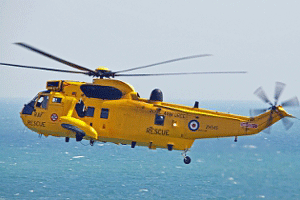 |
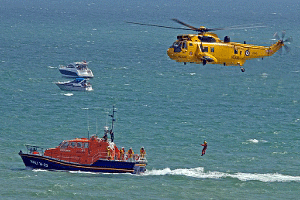 |
||
The Hawker Hunter, “Misdemeanour”, was resplendent in her brightly coloured paint finish, Built in 1956, this Hunter gave its usual high quality display. The Hunter still shows that, for an old aircraft, she has what it takes. The rate of climb is impressive and she looks as exciting to watch as when she was first introduced. The Hunter was sold to numerous countries and had a long and distinguished career stretching back over many years. The Black Arrows 111 Squadron used Hunters for their display team and watching her performance in the 21st Century, one can understand why. The pilot, Jonathon “Flapjack” Whaley is said to have commented about the colour scheme, “It is not a felony to paint a Hunter this way, just a Miss Demeanour”! Jonathon
concluded the display in his “trademark” manner
- with the canopy pushed back and acknowledging the crowd. |
|||
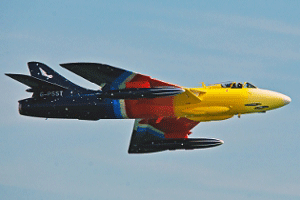 |
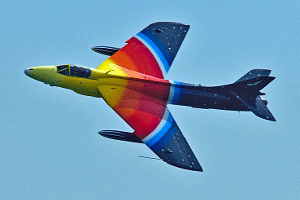 |
||
| The
next type of display always amazes me – why do people
jump out of perfectly airworthy aircraft just for fun? The Royal
Navy Parachute Display team, the Raiders, had variable wind
speeds and some strong gusting to contend with but, every member
of the team, managed to land in the centre of the landing zone. |
|||
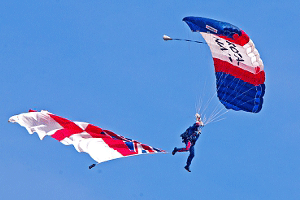 |
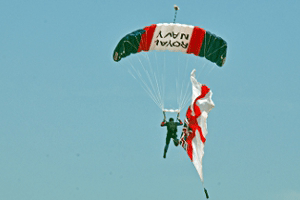 |
||
| The
Blades from Sywell, in Northamptonshire, were as impressive
as ever. These very experienced, ex Red Arrows pilots produce
some of the best team aerobatics in the world – though,
I must say, I am always somewhat taken aback by the high pitched
whine from the Extras’ engines. |
|||
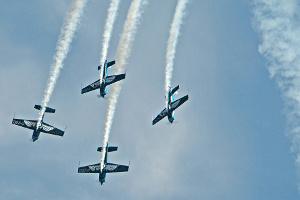 |
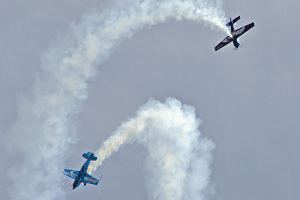 |
||
| Don’t forget to make a point of calling at Sywell, if you are passing. Chances are that you will see the Blades practising – as they do on most days of the week, unless their busy schedule means they are away, performing at an air display or corporate event. They practice 2 or 3 times a day and full flying times are listed daily on the Sywell Aerodrome website in the ‘Status’ area. |
|||
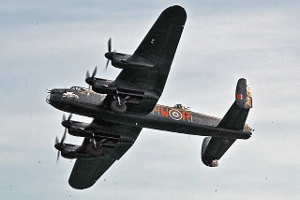 |
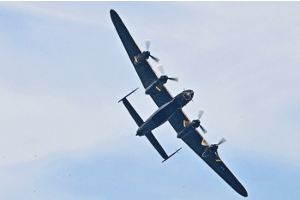 |
||
| The SWIP aerobatic team were among the several who displayed including the Red Bull Matadors and the Patrouille Reva. The BBMF arrived but minus the Hurricane which had developed a technical fault. The Lancaster was escorted by the Mark XIX Spitfire which seems, now, to be the first choice as the display aircraft. As I have commented before, I would prefer to see an earlier mark of Spitfire escorting the Lancaster – I just feel it would be more in keeping with the iconic heavy bomber. Both aircraft gave individual displays. As usual, the Lancaster did several runs in a number of configurations – gear down or bomb doors open make for more interesting shots for photographers and with the sound of four Merlin engines pervading the air – the crowds loved it. |
|||
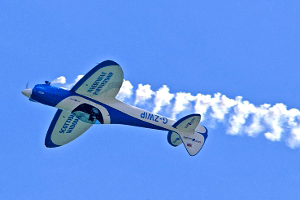 |
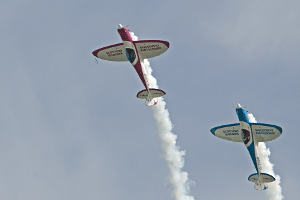 |
||
Well,
we didn’t have the Red Arrows, but, we did have two Folland
Gnats – the former display aircraft used by the Red Arrows.
These two aircraft are part of a new charitable trust set up
to preserve the examples in flying condition. |
|||
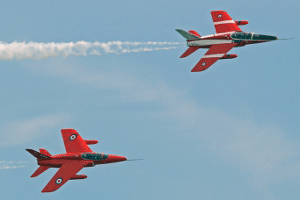 |
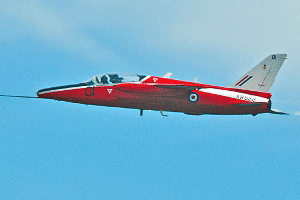 |
||
Slightly larger than the Hawk, the Gnat still showed great agility and performance and the display was immaculately flown to the obvious delight of the crowd. The flying continued with contributions from the Breitling Wingwalkers, the Lynx and the Chinook, the Texan, the Tornado and many, many more. Every year, Airbourne seems to be increasing the number of displays – this year’s displays also included the B17 Fortress, the P51 Mustang and other iconic World War 2 aircraft. So to the star of the show – running in at low level over the sea, the Vulcan was welcomed at Eastbourne and she weaved her magic spell over the crowd. With a display of tight turns, banking and climbing, the Vulcan pulled it off again and I suspect she gained thousands of new fans and will be in demand for as long as she can continue to fly. |
|||
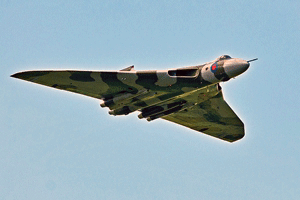 |
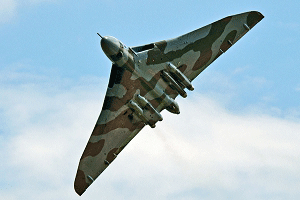 |
||
Recent engine replacements have shown just what a costly task it is to keep her flying but we must hope that the generosity of the public will be sufficient to see her continue to fly for as long as is possible. First sketched as a design by Roy Chadwick in 1946, the Vulcan represents the best in British technical design and innovation. She has rapidly become a star and has been taken to the very hearts of the UK public – a far cry from her role as a Cold War deterrent, designed to deliver nuclear weapons to targets in former Eastern Bloc countries, her missions are all peaceful ones nowadays – something which cannot be said about the famous Vulcan whine and the crackling decibels of her afterburners. We wish you a long life, Special Lady, as you continue to thrill all – young and old alike. It would take a complete book to write about Airbourne in real depth and to list every aircraft that displayed there, Hopefully, this short review, has given readers a taste of what Eastbourne has to offer the aviation enthusiast for 4 full days every summer. It is probably one of the best free air shows you will ever attend. It has the full support of both the town’s businesses and local residents, who readily accept the road closures and “inconvenience” without complaint whilst welcoming thousands of visitors and aircraft fanatics to the town. Not to include Airbourne in your display list for 2013 would be a mistake – see you there, again, next year! |
|||
|
|
|||
| Review
by Dave Briers - click HERE
for Daves Showcase |
|||

